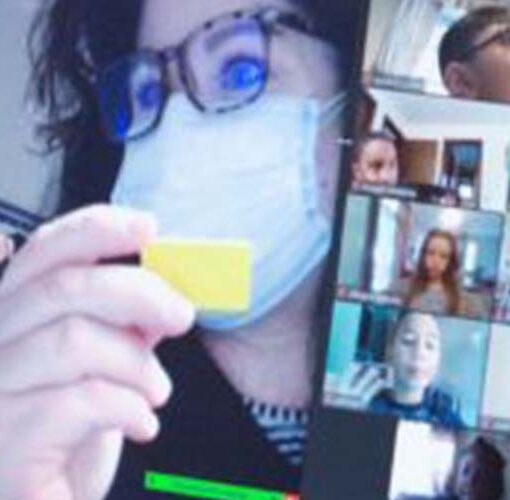Why are we so anxious much of the time?
Anxiety is a natural response to stress, a fear or apprehension about what may happen. To varying degrees, it is part of everyone’s daily life. Having to give a speech or performing a difficult and especially unfamiliar task are common causes of anxiety.
Constant life stressors– income instability, a fear for one’s safety, experiencing bias – can cause anxiety disorder, the most common mental illness in the U.S. According to NIMH, “for a person with an anxiety disorder, the anxiety does not go away and can get worse over time.” A 2019 study found 1 in 7 children are likely to have a mental health disorder. Nearly half of those go untreated.
Not all stress creates anxiety, and not all stress is counterproductive. Stressors like deadlines and evaluations can actually improve performance, but only up to a certain point. It depends on the person and the circumstances.
However, while stress may tick up performance, a state of anxiety never improves learning.
Students can’t learn well when experiencing anxiety.
Anxiety can negatively affect nearly every aspect of learning: cognitive processing, concentration, memory, executive functioning skills, and comfort in the classroom. Those can then be manifested by missing assignments, not participating, poor test taking, behavioral issues, negative or lack of peer interactions, and hating or even refusing to come to school.
Many educators have experienced a drastic increase in students reporting feelings of anxiety over the past few years, even before the pandemic. Nurses and counselors have had to work more with family doctors to ensure such diagnoses are not casually assigned in order to gain accommodations like home instruction that mask or don’t address the real issues, like a learning disability or abuse.
We can help students manage anxiety and its effects on their learning and well-being
There is much educators and parents are doing and can do to help children reduce anxiety and its impact on their lives. Here are some examples from current research and practices in the field:
1. Teach and promote mentally healthy practices in the classroom.
Mental health must be part of every curriculum and lesson plan.
- Help children reframe stress. By framing setbacks as part of the learning process, a growth mindset can reduce anxiety. Adults should focus praise on real effort over results.
- Develop a mental health routine, like this six-day challenge from the NY Times
- Help children understand that anxiety is normal and to recognize what it feels like in order to manage it. Brown University’s Dr. Jud Brewer discusses how to make stress reduction a habit in this Ezra Klein podcast interview.
- Learn exercises to tap into our brain’s resiliency, useful not only for recovering from stress and trauma but for learning. Check out this interview with Columbia University professor and author Dr. Norman Droidge.
2. Attend to the whole child.
Effective and enduring learning is far more than acquiring academic content knowledge and skills.
- Understand each child’s unique and natural temperament. With an open and insightful mind, look through a child’s academic and health records to identify possible hot spots that may indicate anxiety issues.
- Create opportunities for, monitor, and nurture social interactivity. SEL has become practically a cottage industry over the past five years. I’ve linked some effective SEL and anxiety resources below.
- Support parents in developing healthy family routines, talking about school and feelings, and monitoring their children’s screen, diets, and sleep time.
- For more serious cases and causes of anxiety, learn about trauma-informed approaches.
3. Aspire to make every classroom a place children want to be.
While the process of learning is impacted by anxiety, it can also be a cause of it.
- Continue to be aware of and try to create an environment and school wide culture that rejects bias, bullying, and stigmatizing.
- Identify and minimize common classroom stressors, like pop quizzes
- Recognize signs students are experiencing anxiety
- Develop a more high interest and personalized curriculum
- Create activities that help students feel connected– to you, the school, the community, real world issues, and each other
- Pave the way for and help them see a positive future
4. Take advantage of the best mental health resources available.
We can’t be experts at everything and there is no need to reinvent the mental health support wheel.
Advocate for funding to prioritize mental health resources and assure students have access to them. (The Bureau of Labor Statistics recommends five times the number of counselors and social workers currently employed in schools.) Partner with mental health professionals. For example, we used grants to establish onsite, on demand professional therapists two to three times a week.
All of this applies to us adults, too. We need to take care of ourselves if we’re to maximize our chances of helping kids. Children easily sense adult anxieties, but it’s not just “if mama ain’t’ happy, nobody’s happy.” When we are constantly stressed and anxious, it’s like a student who can’t learn. It saps our capacity to teach, sense, relate, and lead.
 Sunsets can be a beautiful way to end a day. We are lucky to live a few minutes from the Atlantic, where sunrise at the Belmar NJ shore reminds me each day is a new opportunity to find peace, joy, and service.
Sunsets can be a beautiful way to end a day. We are lucky to live a few minutes from the Atlantic, where sunrise at the Belmar NJ shore reminds me each day is a new opportunity to find peace, joy, and service.
Our children, family, friends, and colleagues need us.
⚙ Dr. Marc
If you have a friend/colleague who speaks this kind of language, or whom you think would benefit from hearing it, please forward them this post.
Fellow educators and their supporters can also get on my no-pressure mailing list to receive periodic newsletters/blogs and content like this post by using this link.
The Scream by Edvard Munch (1893) from https://www.edvardmunch.org/the-scream.jsp
©2021 Marc Natanagara, Ed.D. All rights reserved. Reprinted with permission.
This article and other resources available at authenticlearningllc.com
When duplicating this post in any form, please make sure to include the attribution above.
June 2021
RESOURCES
Organizations
AnxietyintheClassroom.org
National Assoc of State Mental Health Program Directors: webinars, presentations, free online trainings
Colorado Department of Education: Trauma-Informed Approaches in Schools
Articles
https://selskills.com/self-management/how-to-help-students-manage-anxiety
https://www.edsurge.com/news/2020-04-07-teachers-are-anxious-and-overwhelmed-they-need-sel-now-more-than-ever
https://www.melbournechildpsychology.com.au/blog/5-ways-anxiety-affects-learning-and-8-things-parents-can-do-to-help





